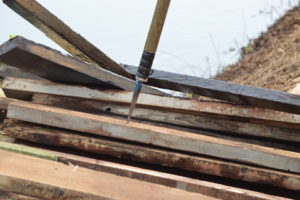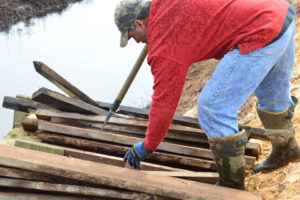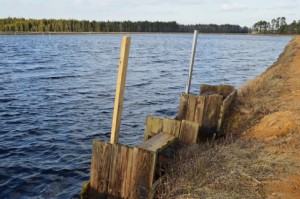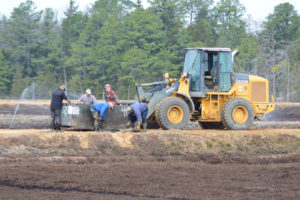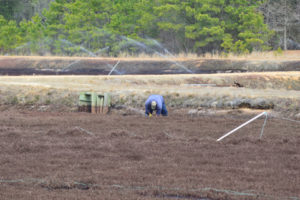Spring finally appears to be hanging in there, which means it’s time to start removing the winter flood! We’ve said it so often you can probably recite it with us by now: good water management is absolutely critical to growing cranberries. Growers rely on a clean, abundant supply to maintain the bogs year round. The key question, as everyone here knows by heart, is “Where is the water coming from, and where do you want it to go?”
Once the harvest is over, the bogs are flooded in order to protect the cranberry vines from the winter weather. When the warmer weather sets in, the bogs are drained so that the dormant vines awaken for the growing season; while cranberries are most frequently harvested using the “wet pick” method, they do not actually grow under water and thus need to go through the same growing cycle as any other fruit crop. The process, which we call “dumping water” is deceptively simple: a team member takes a gate hook (pictured below) and removes the boards that have been placed across the gate in the bog. (The boards are removed in a specific pattern to work with gravity and the natural flow of the water.) Once the boards have been pulled and placed on top of the gate, the water moves to the next bog along the ditches. This water returns to the reservoirs and canals in order to be reused for the next part of the cycle. It takes about 24 hours to drain completely.
“We started the early draw the last week of March, but we decided to put it back on again in some of the Crimson Queen beds,” says Matt Giberson. “We decided we’re going to leave those on later this year, due to issues last year with them getting overripe. But the TAcy was right where it we needed to be so we thought we’d leave the water on to help with rot prevention.” (TAcy is an acronym for “total anthocyanin concentration” and is a unit of color measurement used in a cranberry.) The drawdown started in earnest on the first of April. “We’re shooting for 6 to 7 systems a day by the 25th because we’re going to start planting Cedar Swamp on the 23rd,” Matt says. He’s also trying to balance the needs of the frost team: “I’m trying to keep the focus on the home farm and leave Sim Place till last,” he says. “Sim Place is always a cold spot, so if we don’t have to make someone drive over there for frost I feel better. This week we’re working on the center of the home farm and west of Route 563 this week, and from there we’ll hit the systems at Red Road and Caley before we move on to Sim Place.”
After the water comes off, team member Waldy Blanco goes out with his crew to install sprinklers and make sure the irrigation systems are 100% by turning on the system and letting it run for a while. Then they’ll clean out the nozzles, see where we need to make repairs, and turn the system back on to make sure the repairs worked. Running the system for a bit also helps the team make sure that any potential engine problems are taken care of by the Facilities/Equipment team. It’s important for this to be done as soon as possible for frost protection. Typically, a cranberry bog is built at a lower level than the land immediately surrounding it and the bog temperature can drop ten to fifteen degrees lower than the uplands. These conditions make monitoring bog temperature a top priority once the winter water comes off, which is why installing sprinklers quickly and efficiently is so important.
Right now, the weather appears to be cooperating, and everything seems to be on track for the cold nights coming up in the next week or so!


